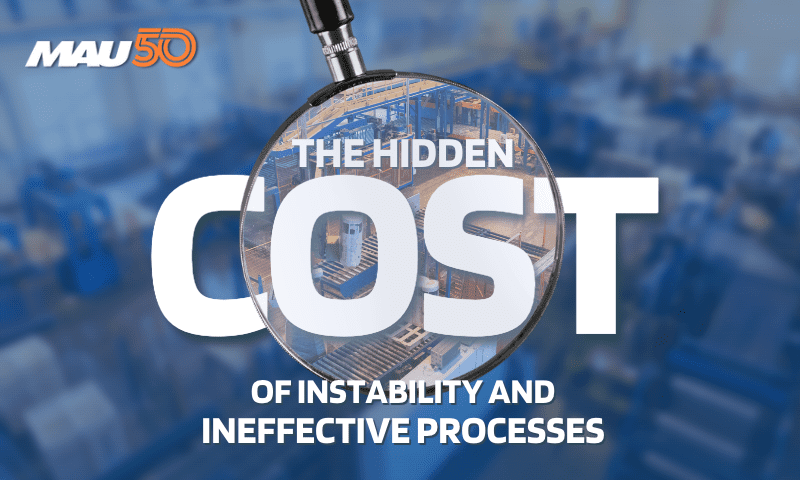Manufacturing success relies heavily on efficiently moving through processes and maintaining a secure system. However, when manufacturers fail to take necessary precautions or use outdated methods, they face hidden cost and increased expenses that could have been prevented with smarter processes or better risk management strategies.
According to market research firm IDC, companies lose 20 to 30 percent in revenue every year due to inefficiencies.
With these hidden costs of instability and ineffective processes, companies have difficulty staying ahead in an ever-changing industry. From dealing with supplier issues to managing inventory correctly, it’s essential for all manufacturers to understand these risks and ensure their policies are strong enough to withstand setbacks.
Identifying the Common Inefficiencies that Manufacturers Face
Identifying and ultimately addressing common inefficiencies in manufacturing systems is essential for organizations hoping to stay ahead of the competition. Common areas of concern include supply chain management and workforce optimization.
The average manufacturer confronts 800 hours of equipment downtime annually — more than 15 hours per week. That downtime comes at a cost, and it isn’t cheap. For example, the average automotive manufacturer loses $22,000 per minute when the production line stops. That quickly adds up. Unplanned downtime costs industrial manufacturers as much as $50 billion annually.
Shutdowns, scheduled or not, can eat up to 1%-10% of available production time.
Poorly managed supply chains can lead to overspending on outsourced parts and materials, increasing production costs and decreasing profit margins. Similarly, an undertrained or disorganized manufacturing workforce can cause various issues, including slow production scheduling and prolonged wait times on customer orders.
Addressing these issues requires careful assessment of existing operations and implementation of proper organizational strategies. With a direct focus on critical problem areas, organizations can strengthen their processes, creating more efficient pathways that improve performance and productivity.
Calculating the Potential Hidden Cost of Errors
Calculating the potential cost of errors due to ineffective processes is crucial for businesses to ensure their ongoing success. The ability to identify and address any inefficiencies quickly and accurately could be the difference between cutting production costs and surviving an economic recession or declaring bankruptcy.
Typical plant maintenance departments operate at an 18% to 74% wrench time rate. Most hover around 20% to 30% efficiency. This means a plant enjoying 74% wrench time might spend $100 million a year versus an unpalatable $400 million that a site with poor efficiency has to pay.
Even when business operations are performing well, preparing for any economic possibilities gives an organization a competitive edge over the competition. Ensuring all processes are future-proof allows companies to stay ahead of regulations while increasing efficiency and accuracy.
Taking the time to thoroughly research how each process can be improved makes it possible to limit mistakes, resulting in higher profits and a sounder bottom line.
How Automation Can Improve Speed and Accuracy While Reducing Costs
Automation in manufacturing comes with many advantages. As automated production reduces the risk of human error, it can increase the speed and accuracy of the manufacturing process while also reducing costs.
With a smart factory, businesses can process orders more quickly than ever before, freeing up valuable employee time and resources to focus on other production areas. Additionally, automated processes can help reduce labor costs by eliminating manual labor and increasing the capacity to produce products faster and more efficiently.
Overall, automation offers manufacturers an ideal solution for improving performance, boosting productivity, and achieving significant cost savings as they explore how to keep their operations running smoothly while staying competitive in today’s market.
Adopting Flexible Strategies to Quickly Address inefficiency and Reduce Hidden Cost
Companies need to invest in flexible strategies for addressing inefficiency and hold-ups to ensure production cycles remain steady and hidden costs stay low.
For instance, organizations should focus on building an agile workforce with robust strategies to ensure flexibility when there is a production slowdown; diversifying the sources of their supplies can help enterprises secure against potential disruptions in the supply chain.
Additionally, organizations must look into effective measures for supply chain optimization, such as timely monitoring of stocks, supply levels, and market conditions for decisions related to raw materials procurement, manufacturing process flowcharts, finished goods inventory management and forecasting demands.
With these approaches, companies can focus on efficiency within their teams, processes, and suppliers while being prepared for any surprises that may arise.
Introducing a Culture of Continuous Improvement
Introducing a culture of continuous improvement could be the key to reducing operational costs. By pursuing a continuous process of examination and optimization, businesses can monitor the efficiency of their organizational processes and identify areas that need improvement or updating.
Continually improving operations can help eliminate wasteful spending and improve overall efficiencies, resulting in much lower costs and higher financial productivity. The initiative should look at each step of the organization’s processes, from customer service to marketing to product design, to reduce unnecessary elements and streamline production where possible.
Implementing this culture will require commitment from those across all departments – but the benefits it brings in terms of cost savings make it well worth the effort.
As manufacturers are challenged by increasing pressure to remain competitive and agile while maintaining a budget, data-driven strategies are essential to success. By improving processes with automation, taking an agile approach, introducing a culture of continuous improvement, and identifying common inefficiencies, manufacturers can reduce operational costs, improve speed and accuracy, and expand their competitive margins.
Ultimately, these strategies equip companies with the right tools and processes to avoid manual entry errors and implement more efficient production models. With the right focus on data-driven decisions, manufacturers can ensure their companies stay ahead of their competition while continuing to produce high-quality products.






